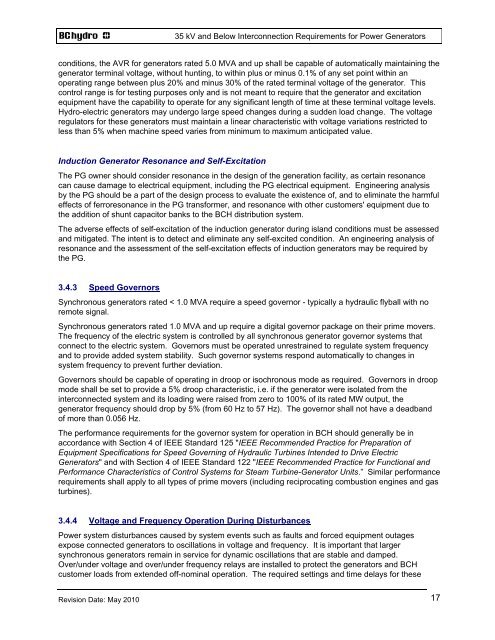35 kV and Below INTERCONNECTION REQUIREMENTS - BC Hydro
35 kV and Below INTERCONNECTION REQUIREMENTS - BC Hydro
35 kV and Below INTERCONNECTION REQUIREMENTS - BC Hydro
You also want an ePaper? Increase the reach of your titles
YUMPU automatically turns print PDFs into web optimized ePapers that Google loves.
Revision Date: May 2010<br />
<strong>35</strong> <strong>kV</strong> <strong>and</strong> <strong>Below</strong> Interconnection Requirements for Power Generators<br />
conditions, the AVR for generators rated 5.0 MVA <strong>and</strong> up shall be capable of automatically maintaining the<br />
generator terminal voltage, without hunting, to within plus or minus 0.1% of any set point within an<br />
operating range between plus 20% <strong>and</strong> minus 30% of the rated terminal voltage of the generator. This<br />
control range is for testing purposes only <strong>and</strong> is not meant to require that the generator <strong>and</strong> excitation<br />
equipment have the capability to operate for any significant length of time at these terminal voltage levels.<br />
<strong>Hydro</strong>-electric generators may undergo large speed changes during a sudden load change. The voltage<br />
regulators for these generators must maintain a linear characteristic with voltage variations restricted to<br />
less than 5% when machine speed varies from minimum to maximum anticipated value.<br />
Induction Generator Resonance <strong>and</strong> Self-Excitation<br />
The PG owner should consider resonance in the design of the generation facility, as certain resonance<br />
can cause damage to electrical equipment, including the PG electrical equipment. Engineering analysis<br />
by the PG should be a part of the design process to evaluate the existence of, <strong>and</strong> to eliminate the harmful<br />
effects of ferroresonance in the PG transformer, <strong>and</strong> resonance with other customers' equipment due to<br />
the addition of shunt capacitor banks to the <strong>BC</strong>H distribution system.<br />
The adverse effects of self-excitation of the induction generator during isl<strong>and</strong> conditions must be assessed<br />
<strong>and</strong> mitigated. The intent is to detect <strong>and</strong> eliminate any self-excited condition. An engineering analysis of<br />
resonance <strong>and</strong> the assessment of the self-excitation effects of induction generators may be required by<br />
the PG.<br />
3.4.3 Speed Governors<br />
Synchronous generators rated < 1.0 MVA require a speed governor - typically a hydraulic flyball with no<br />
remote signal.<br />
Synchronous generators rated 1.0 MVA <strong>and</strong> up require a digital governor package on their prime movers.<br />
The frequency of the electric system is controlled by all synchronous generator governor systems that<br />
connect to the electric system. Governors must be operated unrestrained to regulate system frequency<br />
<strong>and</strong> to provide added system stability. Such governor systems respond automatically to changes in<br />
system frequency to prevent further deviation.<br />
Governors should be capable of operating in droop or isochronous mode as required. Governors in droop<br />
mode shall be set to provide a 5% droop characteristic, i.e. if the generator were isolated from the<br />
interconnected system <strong>and</strong> its loading were raised from zero to 100% of its rated MW output, the<br />
generator frequency should drop by 5% (from 60 Hz to 57 Hz). The governor shall not have a deadb<strong>and</strong><br />
of more than 0.056 Hz.<br />
The performance requirements for the governor system for operation in <strong>BC</strong>H should generally be in<br />
accordance with Section 4 of IEEE St<strong>and</strong>ard 125 "IEEE Recommended Practice for Preparation of<br />
Equipment Specifications for Speed Governing of Hydraulic Turbines Intended to Drive Electric<br />
Generators" <strong>and</strong> with Section 4 of IEEE St<strong>and</strong>ard 122 "IEEE Recommended Practice for Functional <strong>and</strong><br />
Performance Characteristics of Control Systems for Steam Turbine-Generator Units.” Similar performance<br />
requirements shall apply to all types of prime movers (including reciprocating combustion engines <strong>and</strong> gas<br />
turbines).<br />
3.4.4 Voltage <strong>and</strong> Frequency Operation During Disturbances<br />
Power system disturbances caused by system events such as faults <strong>and</strong> forced equipment outages<br />
expose connected generators to oscillations in voltage <strong>and</strong> frequency. It is important that larger<br />
synchronous generators remain in service for dynamic oscillations that are stable <strong>and</strong> damped.<br />
Over/under voltage <strong>and</strong> over/under frequency relays are installed to protect the generators <strong>and</strong> <strong>BC</strong>H<br />
customer loads from extended off-nominal operation. The required settings <strong>and</strong> time delays for these<br />
17
















